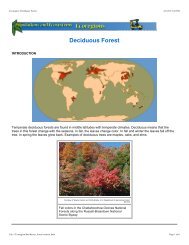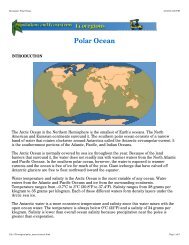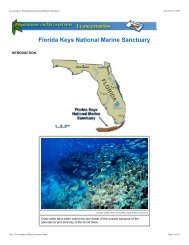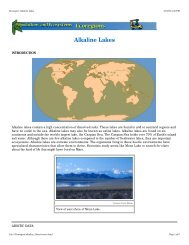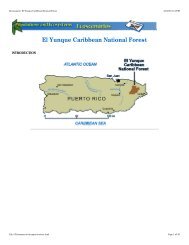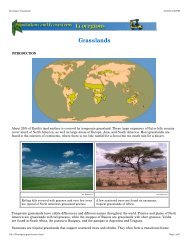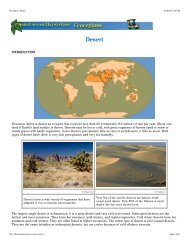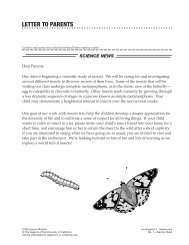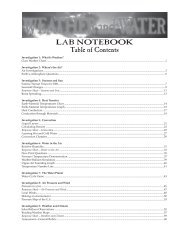Ecoscenarios Combined - FOSSweb
Ecoscenarios Combined - FOSSweb
Ecoscenarios Combined - FOSSweb
You also want an ePaper? Increase the reach of your titles
YUMPU automatically turns print PDFs into web optimized ePapers that Google loves.
Ecoscenario: Yellowstone National Park<br />
4/16/03 3:25 PM<br />
ISSUES<br />
In the early 1900s in an effort to stablize the herds of elk, bison, and mule deer, predators ( wolves, cougars, and<br />
coyotes) were removed or eliminated from the park. By the time it was discovered that it was not predators, but<br />
reduction of winter grazing lands, that had caused the decline, the population of wolves had become dangerously<br />
small. Wolf sightings became rarer and rarer until 1970, when no wolves were reported in Yellowstone National Park.<br />
The reintroduction of wolves has been an issue at Yellowstone National Park. National park policy calls for the<br />
restoration of a species when sufficient habitat exists to support the population, management can prevent threats to<br />
outside interests, the restored species is almost identical to the lost species, and the loss of the species is the<br />
result of human activities.<br />
Wolves were in the Yellowstone ecosystem before the park was founded in 1872. Wolf-removal programs were<br />
instituted to benefit the elk, deer, and moose. By the 1940s sightings of wolves had become rare. In the 1970s there<br />
was no evidence that breeding pairs of wolves remained in Yellowstone.<br />
The wolves were gone, but the population of elks continued to decline. Yellowstone National Park began managing<br />
the elk population, and their numbers increased from 3100 in 1968 to over 30,000 today. Park managers say that elk<br />
are returning the Yellowstone ecosystem to a natural balance, in which elk numbers are limited by food supply.<br />
Others worry that there are now too many elk and that they are changing the landscape of Yellowstone from forest to<br />
elk grazing land. Elk browse on tender aspen saplings, reducing the number that mature. This disrupts the normal<br />
forest succession in Yellowstone.<br />
In 1978 the U.S. Fish and Wildlife Service proposed the reintroduction of wolves into the Yellowstone ecosystem. It<br />
was predicted that the populations of elk, bison, mule deer, and moose would be regulated by wolf predation.<br />
Ranchers and hunters outside the park immediately opposed reintroduction. Ranchers were worried that wolves<br />
would find cattle and sheep easier prey than elk. Hunters were worried that elk populations would be reduced and<br />
that fewer hunting permits would be issued.<br />
file:///Ecoscenario/yellow/content.html<br />
Page 11 of 15



